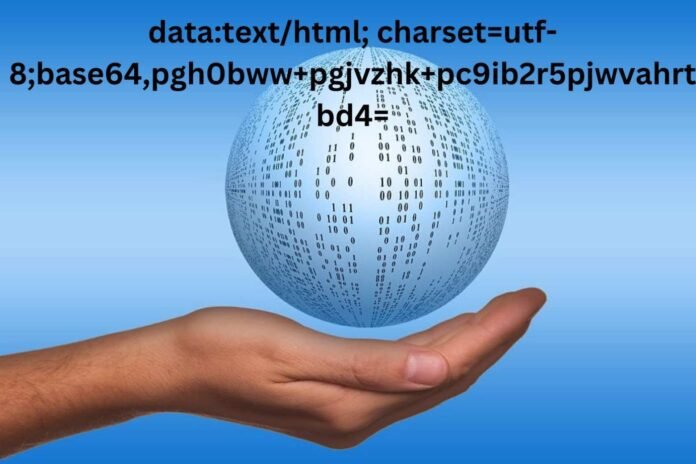Introduction
Modern web development often involves encountering strings such as data:text/html;charset=utf-8;base64,. You might wonder what they mean, how they’re used, and why they matter. This guide breaks down the data: URI scheme with text/html and charset=utf-8 parameters, explains Base64 encoding, and explores real-world usage scenarios like embedding HTML or images directly in code.
We’ll highlight practical benefits such as simplicity and portability, as well as limitations like size overhead. You’ll also learn best practices for using data URIs effectively. Written with expertise, authoritativeness, and trustworthiness in mind, this is your clear, user-friendly resource on working with data:text/html;charset=utf-8;base64,.
1. What Is a data: URI?
A data: URI allows you to embed resource content directly within a URL or HTML instead of linking externally. It’s part of the data URI scheme and follows the format:
data:[<media-type>][;base64],<data>
- data: – the scheme identifier
- <media-type> – optional MIME type (e.g.,
text/html,image/png) - ;base64 – signals that the content is Base64 encoded
- , – separates the header from the data
- <data> – the actual content, either percent-encoded text or Base64-encoded data
This structure makes it possible to package everything in one place—no extra network requests.
2. Why Use text/html;charset=utf-8;base64?
- Content type (
text/html) tells the browser the embedded content is HTML. - Character set (
charset=utf-8) ensures correct decoding for various languages and symbols. - Base64 makes the data safe for embedding, as it converts any binary or special characters into a safe text format.
Example:
data:text/html;charset=utf-8;base64,PCFET0NU...
Here, PCFET0NU... is the Base64-encoded HTML content that the browser decodes and renders.
3. What Is Base64 Encoding?
Base64 is a binary-to-text encoding method. It takes binary data and represents it using 64 specific ASCII characters:
- Uppercase A–Z
- Lowercase a–z
- Numbers 0–9
- Symbols
+and/ =for padding
Base64 increases the size of the original data by about 33% but ensures that the data can be safely placed in contexts where only text is allowed—like HTML attributes or JSON strings.
4. When and Why to Use This Format
a. Embedding HTML snippets or demos
Useful for sharing self-contained examples where the HTML is directly stored in the URL or script.
b. Embedding images in HTML or CSS
You can embed small icons or graphics directly into a page without separate image files:
<img src="data:image/png;base64,...">
c. Offline or single-file packaging
Great for storing an entire project or help document in one file for offline use.
5. Advantages & Disadvantages
Advantages
- Portability – Everything is stored in one file or string.
- Fewer requests – No need for multiple HTTP calls.
- Self-contained – Ideal for demos, email templates, and prototypes.
Disadvantages
- Increased size – Around 33% bigger than the original data.
- Poor caching – Inline data can’t be cached separately.
- Readability issues – Long encoded strings are hard to maintain.
- Possible length limits – Some environments limit data URI size.
6. Best Practices
To keep your projects efficient and maintainable:
- Use for small assets – Perfect for icons, snippets, or quick demos, not large files.
- Keep it documented – Comment your code so others know what the Base64 data represents.
- Compress before encoding – Reduces total size.
- Test in target browsers – Especially if length limits might be a concern.
- Avoid overuse – Large or numerous Base64 strings can slow down loading times.
7. LSI Keywords
These related terms help search engines understand the topic:
- data URI scheme
- Base64 encoded HTML
- embed HTML in URL
- inline HTML resource
- Base64 overhead
- UTF-8 encoding in data URL
- inline Base64 HTML snippet
Read More: Why Use Fidzholikohixy: Your All-in-One Productivity Solution
Conclusion
Embedding HTML using data:text/html;charset=utf-8;base64, is a powerful technique for creating self-contained, portable code. It specifies both the type of content and the character encoding, ensuring that the data is displayed correctly in browsers. Base64 encoding protects the data from being corrupted by unsafe characters, but it also increases file size and can limit caching efficiency.
This method is best reserved for scenarios where portability and simplicity outweigh performance concerns—such as code demos, offline packages, or small embedded assets. By following best practices like limiting usage to small files, commenting code, and testing across browsers, developers can make the most of this technique without introducing unnecessary complexity.
When used wisely, data:text/html;charset=utf-8;base64, is a versatile tool in a web developer’s toolkit—combining clarity, efficiency, and flexibility in a single, compact format.
FAQs
1. What does data:text/html;charset=utf-8;base64, mean?
It’s a data URI containing Base64-encoded HTML, specifying the content type and character set for correct rendering.
2. Why is Base64 used in data URIs?
It safely represents binary or special characters in a text-only format suitable for embedding in HTML or CSS.
3. Is it supported in all browsers?
Yes, all modern browsers support it, though some older versions may have strict length limits.
4. How much bigger is Base64 data?
On average, Base64 increases data size by about one-third compared to the original.
5. When should I avoid using it?
Avoid it for large files or frequently updated resources where caching and performance matter.
